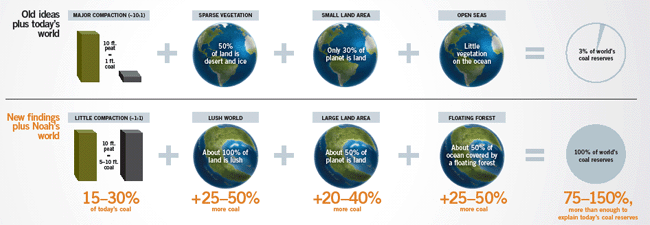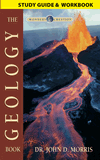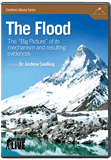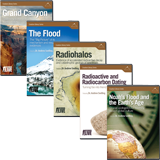How Did We Get All This Coal?
Thankfully, the earth is filled with huge reserves of coal. But that raises an interesting question if most of this coal was formed during the recent, global Flood. Were enough plants alive at the same time to produce so much coal so quickly?
The USA has more than seven trillion tons of coal reserves.1 Similar huge coal deposits lie underground in Canada, Australia, China, South Africa, and other countries. In many cases, the coalfields are not just one bed but multiple coal beds stacked between other fossil-bearing sedimentary rock layers. Where did all this coal come from?
Each coal bed may be inches to feet thick, formed by the accumulation and compacting of thick piles of dead plant material. It has been estimated that, if all the vegetation living on the earth’s surface today were converted to coal, it would amount to only a small fraction—perhaps 3 percent—of the earth’s coal reserves.2
So where did all this vegetation buried in the coal beds come from? And if all these coal beds were formed during the year-long Genesis Flood only about 4,300 years ago, how did we get all this coal so quickly?
The Quantity of Vegetation Required
These new ideas can explain the growth of the vegetation now in the coal beds.
The estimated quantity depends on how thick a pile of vegetation, called peat, needs to be compressed and converted into coal. It is usually claimed that it takes a peat layer 8–10 feet thick to produce each foot of coal.3
However, if you compare the energy content of the coal to that of the peat (the calorific value, or energy from burning), or if you compare the weight of equal volumes of coal and peat, in both cases the peat-to-coal compaction ratio would be only about 2 to 1!4
Furthermore, studies of coal beds that are in contact with sandstone layers, along with studies of dinosaur tracks where dinosaurs must have walked on top of the peat layers before their burial to eventually form coal beds, demonstrate that peat-to-coal compaction ratios of between 2 to 1 and 1 to 1 are more realistic.5 Such ratios are also consistent with the measured compaction around many coal balls (limestone nodules containing fossils of plants and/or marine snails, clams, or lampshells) and compaction of wood that is sometimes found in coal beds.
The estimate that all the vegetation alive on earth today would produce only about 3 percent of the earth’s coal reserves is based on a compaction ratio of somewhere between 10 to 1 and 8 to 1. If that compaction ratio is only between 2 to 1 and 1 to 1, then today’s volume of vegetation would produce 15–30 percent of the known coal reserves. Where did the rest come from?
Today’s Sparse Vegetation
More than half of today’s land surface is covered by deserts, ice sheets, or only sparse vegetation. Under the central Australian deserts and Africa’s Sahara Desert is evidence of lush vegetation that grew there during the post-Flood Ice Age—a time of both rapid ice sheet accumulation and plentiful rain at and near the earth’s equator. Furthermore, thick coal beds under some of the Antarctic ice sheet suggest that continent was also once covered in lush vegetation.
Thus, if all today’s land surface were covered with lush vegetation, as the pre-Flood land surface likely was, then the volume of vegetation would at least double. With minimal compaction, that amount would account for 50 percent or more of the known coal reserves.
In today’s world the earth’s surface is roughly 30 percent land and 70 percent ocean. However, the Bible’s description of dry land on Day Three of Creation (Genesis 1:9–10), along with evidence that some of this land was later piled into high mountain ranges during the Flood, might imply there was 50 percent land and 50 percent seas in the pre-Flood world. That would almost double the land surface covered in lush vegetation. If true, even more of today’s coal beds would be accounted for.
Yet there are other sources of vegetation not seen on earth today.
Unique Pre-Flood Vegetation Found in Coal
Much of the vegetation found fossilized in the coal beds is very different from today’s vegetation. The “Carboniferous” coal beds of the Northern Hemisphere, which stretch from the Appalachian Mountains in the USA through England and Europe, all the way to the Urals of Russia, consist of fossil lycopod trees (giant relatives of today’s tiny forest-floor plants known as club mosses), giant ferns, conifers, giant rushes, and extinct seed ferns. Clearly, different vegetation grew back then.
Most of these plants had hollow stems and roots. Their hollow, lightly-built structures were not designed for growing in soils but for floating on water.6 So these fossil plants appear to represent the remains of a floating-forest biome (or ecosystem), which also included odd reptiles and fish. A small-scale equivalent is found today in quaking bogs (mats of spongy bog vegetation that float over lakes).
Thus in the pre-Flood world the oceans once had vast mats of floating forests that apparently grew out from the coastlines, fringing the original supercontinent, particularly where the seas were shallow.7 The volume of this unique vegetation is now preserved in the Northern Hemisphere’s “Carboniferous” coal beds. The extent of these beds would suggest that perhaps as much as half the pre-Flood sea surface was covered with these floating forest mats.
If half the planet was once a supercontinent above the ocean and floating forest mats covered half of the ocean itself, then as much as 75 percent of the earth’s pre-Flood surface could have been covered by lush vegetation—more than six times the area covered by vegetation on the present earth’s surface. These calculations would thus indicate there was more than enough lush vegetation growing on the pre-Flood earth surface to provide the volume of vegetation to form today’s coal beds.
Converting Vegetation to Coal
Once buried, how quickly could this vegetation be compacted and converted to coal? Laboratory experiments have successfully produced coal-like materials rapidly, under conditions intended to simulate the conditions when actual coal beds accumulated.
A research team at the Argonne National Laboratory in Illinois made material resembling coal by heating plant materials with clay minerals at 302°F (150°C) for two to eight months in the absence of oxygen. After a series of such experiments, the team concluded that coal can be produced directly from plant materials via thermal reactions speeded up by the clay minerals in only one to four months.8 Other experiments have also confirmed that clay particles act as chemical catalysts in a rapid coal-forming process.9 It is thus significant that clay minerals often account for up to 80 percent of the non-plant matter in actual coal.
Subsequent experiments have more closely simulated natural geologic conditions, with temperatures of only 257°F (125°C) and lower pressures (equivalent to burial under 5,905 feet [1,800 meters] of wet sediments).10 After only 75 days, the original plant and wood materials still transformed into coal material, comparable chemically to coal from the same area of Indonesia.
Because these experiments simulated natural conditions, we can be confident that the coal-forming process is rapid and requires only months. So there is no reason to insist that coal formation requires millions of years.
How Did Noah’s World Produce So Much Coal?

Click to enlarge
Some people have wondered how the vegetation during Noah’s day could produce so much coal, since today’s vegetation would produce only 3% of known coal reserves. To find the answer, we must reexamine the assumptions behind that estimate.
First, it is often assumed that around 10 feet of peat is necessary to produce 1 foot of coal. But if you consider the weight of peat and coal, or if you consider the energy content, then 10 feet of vegetation probably produced 5–10 feet of coal.
Second, it is mistakenly assumed that the world of Noah’s day was much like today. That is not the case. It turns out that Noah’s world was very lush, producing nearly six times more vegetation than we see today.
Conclusion
It appears that lush vegetation might have covered up to 75 percent of the pre-Flood world, including the floating forests fringing the land. The Flood waters rose from the oceans and swept over the land, catastrophically destroying and burying all the vegetation in beds between other fossil-bearing sediments. The temperatures and pressures at these depths, aided by the presence of water and clay, converted these beds into coal within months.
Thus the huge coal deposits of today’s world can easily be explained.11 The coal formed quickly in the year-long Genesis Flood only about 4,300 years ago. This coal is a grim reminder that God judged the world because it had become filled with wickedness, corruption, and violence (Genesis 6:11–13). Yet God also shows His mercy. He used the Flood judgment to provide the huge coal resources so much of the world depends upon today.
Answers Magazine
April – June 2013
What unique conditions were required to start the Ice Age, and where does it fit in Bible times? Why did Ice Age animals grow so big, and what happened to them? Also, can you explain why God made more species of beetles than any other animal? Can you prove that Genesis 1–3 is not a Near Eastern myth? Read the answers to these questions and many, many more in this issue!
Browse Issue SubscribeFootnotes
- J. Davidson, W. E. Reed, and P. M. Davis, Exploring Earth: An Introduction to Physical Geology (Upper Saddle River, New Jersey: Prentice Hall, 1997), p. 423.
- A. A. Snelling, Earth’s Catastrophic Past: Geology, Creation and the Flood (Dallas, Texas: Institute for Creation Research, 2009), p. 960. It might be argued that because some coal beds are likely post-Flood, then this three percent estimate is too low. However, a lot of the vegetation in post-Flood coal beds is likely to be from pre-Flood vegetation still floating as debris on the post-Flood ocean surfaces, simply because there may not have been enough time between the end of the Flood and the deposition of those coal beds to grow the new forests to supply the needed volume of vegetation. Thus this 3 percent estimate represents the worst case scenario for the following calculations.
- C. F. K., Diessel, Coal-bearing Depositional Systems (Berlin: Springer-Verlag, 1992), pp. 1, 12.
- J. Scheven, “Floating Forests on Firm Grounds: Advances in Carboniferous Research,” Biblical Creation 3.9 (1981): 36–43.
- G. C. Nadon, “Magnitude and Timing of Peat-to-coal Compaction,” Geology 26.8 (1998): 727–730.
- J. Scheven, “The Carboniferous Floating Forest—an Extinct Pre-Flood Ecosystem,” Creation Ex Nihilo Technical Journal 10.1 (1996): 70–81.
- K. P. Wise, “The Pre-Flood Floating Forest: A Study in Paleontological Pattern Recognition,” in Proceedings of the Fifth International Conference on Creationism, ed. R. L. Ivey, Jr. (Pittsburgh, Pennsylvania: Creation Science Fellowship, 2003), pp. 371–381; K. P. Wise, “Sinking a Floating Forest,” Answers 3.4 (2008): 40–45.
- R. Hayatsu, R. L. McBeth, R. G. Scott, R. E. Botto, and R. E. Winans, “Artificial Coalification Study: Preparations and Characterization of Synthetic Macerals,” Organic Geochemistry 6 (1984): 463–471.
- J. D. Saxby, P. Chatfield, G. H. Taylor, J. D. FitzGerald, I. R. Kaplan and S. T. Lu, “Effect of Clay Minerals on Products from Coal Maturation,” Organic Geochemistry 18, no. 3 (1992): 373–383.
- W. H. Orem, S. G. Neuzil, H. E. Lerch, and C. B. Cecil, “Experimental Early-stage Coalification of a Peat Sample and a Petrified Wood Sample from Indonesia,” Organic Geochemistry 24.2 (1996): 111–125.
- For more details, see chapters 70–71 and 120, and pp. 584–586 of A. A. Snelling, Earth’s Catastrophic Past: Geology, Creation and the Flood (Dallas, Texas: Institute for Creation Research, 2009).
Recommended Resources

Answers in Genesis is an apologetics ministry, dedicated to helping Christians defend their faith and proclaim the good news of Jesus Christ.
- Customer Service 800.778.3390
- © 2025 Answers in Genesis






